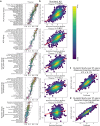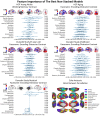Improving predictability, reliability, and generalizability of brain-wide associations for cognitive abilities via multimodal stacking
- PMID: 40575708
- PMCID: PMC12199782
- DOI: 10.1093/pnasnexus/pgaf175
Improving predictability, reliability, and generalizability of brain-wide associations for cognitive abilities via multimodal stacking
Abstract
Brain-wide association studies (BWASs) have attempted to relate cognitive abilities with brain phenotypes, but have been challenged by issues such as predictability, test-retest reliability, and cross-cohort generalizability. To tackle these challenges, we proposed a machine learning "stacking" approach that draws information from whole-brain MRI across different modalities, from task-functional MRI (fMRI) contrasts and functional connectivity during tasks and rest to structural measures, into one prediction model. We benchmarked the benefits of stacking using the Human Connectome Projects: Young Adults (n = 873, 22-35 years old) and Human Connectome Projects-Aging (n = 504, 35-100 years old) and the Dunedin Multidisciplinary Health and Development Study (Dunedin Study, n = 754, 45 years old). For predictability, stacked models led to out-of-sample r∼0.5-0.6 when predicting cognitive abilities at the time of scanning, primarily driven by task-fMRI contrasts. Notably, using the Dunedin Study, we were able to predict participants' cognitive abilities at ages 7, 9, and 11 years using their multimodal MRI at age 45 years, with an out-of-sample r of 0.52. For test-retest reliability, stacked models reached an excellent level of reliability (interclass correlation > 0.75), even when we stacked only task-fMRI contrasts together. For generalizability, a stacked model with nontask MRI built from one dataset significantly predicted cognitive abilities in other datasets. Altogether, stacking is a viable approach to undertake the three challenges of BWAS for cognitive abilities.
Keywords: cognitive abilities; generalizability; reliability; stacking; task fMRI.
© The Author(s) 2025. Published by Oxford University Press on behalf of National Academy of Sciences.
Figures





Update of
-
Improving Predictability, Reliability and Generalisability of Brain-Wide Associations for Cognitive Abilities via Multimodal Stacking.bioRxiv [Preprint]. 2025 Mar 5:2024.05.03.589404. doi: 10.1101/2024.05.03.589404. bioRxiv. 2025. Update in: PNAS Nexus. 2025 Jun 24;4(6):pgaf175. doi: 10.1093/pnasnexus/pgaf175. PMID: 38746222 Free PMC article. Updated. Preprint.
Similar articles
-
Improving Predictability, Reliability and Generalisability of Brain-Wide Associations for Cognitive Abilities via Multimodal Stacking.bioRxiv [Preprint]. 2025 Mar 5:2024.05.03.589404. doi: 10.1101/2024.05.03.589404. bioRxiv. 2025. Update in: PNAS Nexus. 2025 Jun 24;4(6):pgaf175. doi: 10.1093/pnasnexus/pgaf175. PMID: 38746222 Free PMC article. Updated. Preprint.
-
Predicting cognitive decline: Deep-learning reveals subtle brain changes in pre-MCI stage.J Prev Alzheimers Dis. 2025 May;12(5):100079. doi: 10.1016/j.tjpad.2025.100079. Epub 2025 Feb 6. J Prev Alzheimers Dis. 2025. PMID: 39920001 Free PMC article.
-
Occupational therapy for cognitive impairment in stroke patients.Cochrane Database Syst Rev. 2022 Mar 29;3(3):CD006430. doi: 10.1002/14651858.CD006430.pub3. Cochrane Database Syst Rev. 2022. PMID: 35349186 Free PMC article.
-
Systemic pharmacological treatments for chronic plaque psoriasis: a network meta-analysis.Cochrane Database Syst Rev. 2021 Apr 19;4(4):CD011535. doi: 10.1002/14651858.CD011535.pub4. Cochrane Database Syst Rev. 2021. Update in: Cochrane Database Syst Rev. 2022 May 23;5:CD011535. doi: 10.1002/14651858.CD011535.pub5. PMID: 33871055 Free PMC article. Updated.
-
Signs and symptoms to determine if a patient presenting in primary care or hospital outpatient settings has COVID-19.Cochrane Database Syst Rev. 2022 May 20;5(5):CD013665. doi: 10.1002/14651858.CD013665.pub3. Cochrane Database Syst Rev. 2022. PMID: 35593186 Free PMC article.
References
-
- Deary IJ, Pattie A, Starr JM. 2013. The stability of intelligence from age 11 to age 90 years: the Lothian Birth Cohort of 1921. Psychol Sci. 24:2361–2368. - PubMed
-
- Deary IJ, Strand S, Smith P, Fernandes C. 2007. Intelligence and educational achievement. Intelligence. 35:13–21.
-
- Schmidt FL, Hunter J. 2004. General mental ability in the world of work: occupational attainment and job performance. J Pers Soc Psychol. 86:162–173. - PubMed
Grants and funding
LinkOut - more resources
Full Text Sources

